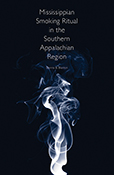Mississippian Smoking Ritual in the Southern Appalachian Region

North American Indians cultivated tobacco beginning in prehistory, often through great effort and for multiple reasons. Especially valued for its narcotic effects, however, tobacco was assigned sacred status and became a necessary component for any event with cultural or religious significance. As such, ritualistic tobacco use joined cult usage of other plants as Native American societies evolved throughout the Mississippian time period.
In Mississippian Smoking Ritual in the Southern Appalachian Region, Dennis B. Blanton surveys smoking pipes found at archaeological sites throughout southern Appalachia and neighboring areas to present a holistic picture of Native American smoking rituals in the region. While tobacco could also be eaten or infused into tea, native peoples traditionally dried the leaves and smoked them in increasingly ornate pipes. The ritual importance of tobacco translated into a similar status for smoking pipes. Mississippian pipe traditions varied throughout the region but in accordance with distinctive cultural patterns. Blanton’s research ties pipe usage and pipe-smoking traditions to particular pipe forms, and sometimes to specific sites, and in doing so, he further informs our knowledge of the complexities of Mississippian societies and their myriad ceremonial rituals.
Mississippian Smoking Ritual in the Southern Appalachian Region is an especially useful text for understanding ritual behavior and its patterns of change over time. The historical trajectory of tobacco begins with adherence to a longstanding smoking tradition but evolves into a complex ceremonial practice with equally complex forms of tobacco pipes. This regional study demonstrates how smoking rituals changed as broader cultural shifts redefined the Mississippian Era, bringing archaeologists closer to answering the elusive macro question of why rituals evolved within Native American cultures.
